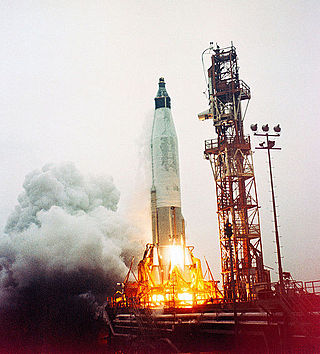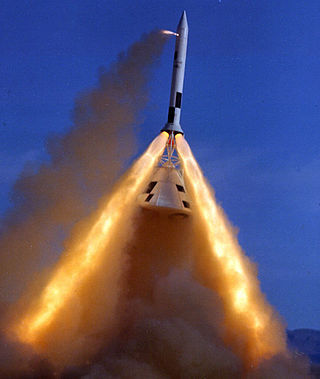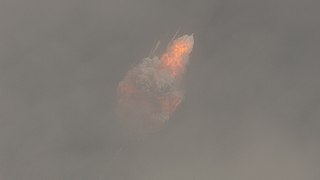
Project Mercury was the first human spaceflight program of the United States, running from 1958 through 1963. An early highlight of the Space Race, its goal was to put a man into Earth orbit and return him safely, ideally before the Soviet Union. Taken over from the US Air Force by the newly created civilian space agency NASA, it conducted 20 uncrewed developmental flights, and six successful flights by astronauts. The program, which took its name from Roman mythology, cost $2.57 billion. The astronauts were collectively known as the "Mercury Seven", and each spacecraft was given a name ending with a "7" by its pilot.

The Apollo spacecraft was composed of three parts designed to accomplish the American Apollo program's goal of landing astronauts on the Moon by the end of the 1960s and returning them safely to Earth. The expendable (single-use) spacecraft consisted of a combined command and service module (CSM) and an Apollo Lunar Module (LM). Two additional components complemented the spacecraft stack for space vehicle assembly: a spacecraft–LM adapter (SLA) designed to shield the LM from the aerodynamic stress of launch and to connect the CSM to the Saturn launch vehicle and a launch escape system (LES) to carry the crew in the command module safely away from the launch vehicle in the event of a launch emergency.

Mercury-Atlas 1 (MA-1) was the first attempt to launch a Mercury capsule and occurred on July 29, 1960 at Cape Canaveral, Florida. The spacecraft was unmanned and carried no launch escape system. The Atlas rocket suffered a structural failure 58 seconds after launch at an altitude of approximately 30,000 feet (9.1 km) and 11,000 feet (3.4 km) down range. All telemetry signals suddenly ceased as the vehicle was passing through Max Q. Because the day was rainy and overcast, the booster was out of sight from 26 seconds after launch, and it was impossible to see what happened.

Mercury-Redstone 2 (MR-2) was the test flight of the Mercury-Redstone Launch Vehicle just prior to the first crewed American space mission in Project Mercury. Carrying a chimpanzee named Ham on a suborbital flight, Mercury spacecraft Number 5 was launched at 16:55 UTC on January 31, 1961, from LC-5 at Cape Canaveral, Florida. The capsule and Ham, the first great ape in space, landed safely in the Atlantic Ocean 16 minutes and 39 seconds after launch.

Little Joe 1 (LJ-1) was a failed launch of a Little Joe by NASA, a solid fuel rocket that was designed for a Max Q abort and launch escape system test for the Mercury capsule. The objective was to determine how well the escape rocket would function under the most severe dynamic loading conditions anticipated during a Mercury-Atlas launching.

The Little Joe 1B was a launch escape system test of the Mercury spacecraft, conducted as part of the U.S. Mercury program. The mission also carried a female rhesus monkey named Miss Sam in the Mercury spacecraft. The mission was launched January 21, 1960, from Wallops Island, Virginia. The Little Joe 1B flew to an apogee of 9.3 statute miles (15.0 km) and a range of 11.7 miles (18.9 km) out to sea. Miss Sam survived the 8 minute 35 second flight in good condition. The spacecraft was recovered by a Marine helicopter and returned to Wallops Island within about 45 minutes. Miss Sam was one of many monkeys used in space travel research.

Little Joe 5 was the November 8, 1960, unmanned atmospheric test flight of the Mercury spacecraft, conducted as part of the U.S. Mercury program. The objective was to test a production Mercury capsule (#3) and the launch escape system during an ascent abort at maximum dynamic pressure. The mission was launched from Wallops Island, Virginia. Sixteen seconds after liftoff, the escape rocket and the tower jettison rocket both fired prematurely. Furthermore, the booster, capsule, and escape tower failed to separate as intended. The entire stack was destroyed on impact with the Atlantic Ocean. The Little Joe 5 flew to an apogee of 10.1 miles (16.2 km) and a range of 13 miles (20.9 km). Some capsule and booster debris was recovered from the ocean floor for post flight analysis.

Little Joe 5A was an uncrewed launch escape system test of the Mercury spacecraft, conducted as part of the U.S. Mercury program. It was an attempted re-test of the failed Little Joe 5 flight. The mission used production Mercury spacecraft #14 atop a Little Joe booster rocket. The mission was launched March 18, 1961, from Wallops Island, Virginia. The LJ-5 failure sequence was repeated when capsule escape rocket again ignited prematurely with the capsule remaining attached to the booster. In this flight however, a ground command was sent to separate the capsule from the booster and escape tower. This allowed the main and reserve parachutes to deploy and the capsule was recovered with only minor damage. It would be used again on the subsequent Little Joe 5B mission, in a third attempt to achieve mission objectives. The Little Joe 5A flew to an apogee of 7.7 miles (12 km) and a range of 18 miles (29 km). The mission lasted 5 minutes 25 seconds. Maximum speed was 1,783 miles per hour (2,869 km/h) and acceleration was 8 G (78 m/s²).

A-001 was the second abort test of the Apollo spacecraft.

A-002 was the third abort test of the Apollo spacecraft.

A-003 was the fourth abort test of the Apollo spacecraft. This particular flight is notable because during the abort test flight, an actual abort situation occurred, and further proved the Apollo launch escape system (LES). The CM was successfully pulled away from the malfunctioning Little Joe booster and it landed safely under parachutes.

A-004 was the sixth and final test of the Apollo launch escape vehicle and the first flight of a Block I production-type Apollo Command/Service Module.

Little Joe II was an American rocket used from 1963 to 1966 for five uncrewed tests of the Apollo spacecraft launch escape system (LES), and to verify the performance of the command module parachute recovery system in abort mode. It was named after a similar rocket designed for the same function in Project Mercury. Launched from White Sands Missile Range in New Mexico, it was the smallest of four launch rockets used in the Apollo program.

Little Joe was a solid-fueled booster rocket used by NASA for eight launches from 1959 to 1960 from Wallops Island, Virginia to test the launch escape system and heat shield for Project Mercury capsules, as well as the name given to the test program using the booster. The first rocket designed solely for crewed spacecraft qualifications, Little Joe was also one of the pioneer operational launch vehicles using the rocket cluster principle.

A launch escape system (LES) or launch abort system (LAS) is a crew-safety system connected to a space capsule. It is used in the event of a critical emergency to quickly separate the capsule from its launch vehicle in case of an emergency requiring the abort of the launch, such as an impending explosion. The LES is typically controlled by a combination of automatic rocket failure detection, and a manual activation for the crew commander's use. The LES may be used while the launch vehicle is still on the launch pad, or during its ascent. Such systems are usually of three types:

A boilerplate spacecraft, also known as a mass simulator, is a nonfunctional craft or payload that is used to test various configurations and basic size, load, and handling characteristics of rocket launch vehicles. It is far less expensive to build multiple, full-scale, non-functional boilerplate spacecraft than it is to develop the full system. In this way, boilerplate spacecraft allow components and aspects of cutting-edge aerospace projects to be tested while detailed contracts for the final project are being negotiated. These tests may be used to develop procedures for mating a spacecraft to its launch vehicle, emergency access and egress, maintenance support activities, and various transportation processes.
A pad abort test is a test of a launch escape system to determine how well the system could get the crew of a spacecraft to safety in an emergency on the launch pad.

The Atlas LV-3B, Atlas D Mercury Launch Vehicle or Mercury-Atlas Launch Vehicle, was a human-rated expendable launch system used as part of the United States Project Mercury to send astronauts into low Earth orbit. Manufactured by Convair, it was derived from the SM-65D Atlas missile, and was a member of the Atlas family of rockets. With the Atlas having been originally designed as a weapon system, testing and design changes were made to the missile to make it a safe and reliable launch vehicle. After the changes were made and approved to, the US launched the LV-3B nine times, four of which had crewed Mercury spacecraft.

Ascent Abort-2 (AA-2) was a test of the launch escape system (LAS) of NASA's Orion spacecraft.

SpaceXCrew Dragon In-Flight Abort Test was a successful test of the SpaceX Dragon 2 abort system, conducted on 19 January 2020. It was the final assessment for the Crew Dragon capsule and Falcon 9 launch system before they would be certified to carry humans into space. Booster B1046.4 and an uncrewed capsule C205 were launched from Launch Complex 39A (LC-39A) on a suborbital trajectory, followed by an in-flight abort of the capsule at max Q and supersonic speed. The test was carried out successfully: the capsule pulled itself away from the booster after launch control commanded main engine shutdown and landed safely.



















